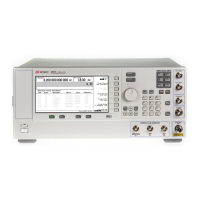E8257D/67D, E8663D PSG Signal Generators Service Guide
Troubleshooting
Troubleshooting Assembly–Level Problems
1-53
• If the pulse is not present, perform the A11 Pulse/Analog Modulation Generator self–test, and follow the
troubleshooting procedure.
4. If pulse modulation is working, perform the A8 Output self–test.
• If the self–test passes, refer to “Troubleshooting the RF Path” on page 1- 75, and check the lowband (<3.2 GHz)
path.
• If the self–test fails, refer to the A8 Output test troubleshooting.
1206 20 GHz IQ Modulator
1. If the power supplies +8V AF, +2.5V AF, +9V AFSW, +12V AFSW, +15V VLIMF, or −15VSWBIAS fail, refer to the
tablepage 1- 50, and check the supplies used by the A35 I/Q Modulator as they leave the A26 MID connector.
• If the signals are good at the A26 MID connector, replace the A35 I/Q Modulator.
2. If the VD724 Doubler, test index 6, fails, replace the A35 I/Q Modulator.
3. If self–test TC672RF indexes 8, 9, 11, or 12 fail:
a. Remove the cable from J2 of the A29 20 GHz Doubler.
b. While measuring the signal at J2 with a spectrum analyzer, run self–test 1206. You should see a +20 dBm
signal at 5 GHz.
• If the signal is bad, troubleshoot the RF path.
• If the signal is good and TC672RF indexes 8, 11, or 12 have failed, replace the A35 I/Q Modulator.
• If the signal is good and TC672RF index 9 has failed, you must also check the I/Q signals from the A13 I/Q
Multiplexer:
1. Remove the cable from J6 (I) of the A35 I/Q Modulator, and connect it to an oscilloscope.
2. Execute a single 1206 self–test. The signal on the oscilloscope should pulse to approximately −0.5 Vdc
for approximately 500 ms.
— If the signal is bad, refer to the A13 I/Q Multiplexer troubleshooting.
3. If the signal is good, reconnect the cable to J6, remove the cable to J7 (Q), and connect this cable to the
oscilloscope.
4. Execute a single 1206 self–test. The signal on the oscilloscope should pulse to approximately
18 millivolts for approximately 500 ms.
— If the signal is bad, refer to the A13 I/Q Multiplexer troubleshooting.
— If both the I and Q signals are good, replace the A35 I/Q Modulator.
4. If self–test Quad Loop Integrator fails, replace the A35 I/Q Modulator.
1207 Upconverter
1. If the power supplies +6.5V or +5.2V fail, refer to the tablepage 1- 50, and check the supplies used by the
A37 Upconverter as they leave the A26 MID connector.
• If the signals are good at the A26 MID connector, replace the A37 Upconverter.
2. If any of the drain currents fail (test indexes 3 through 18), replace the A37 Upconverter.
3. If self–tests ALC (indexes 18 through 32) Vdet (indexes 24 through 26) fail:
a. On the signal generator, set the following:
Center Frequency: Value at which ACL or Vdet self–test failed (e.g. 20.01 GHz, 28.5 GHz, etc.)
Power: +20 dBm
RF: On
b. Disconnect A35–J24 and connect a spectrum analyzer to the A35 I/Q Modulator. This is the IF signal to the
A37 Upconverter.
c. For RF signals >20 GHz to 28.5 GHz, the IF signal is mixed with the LO to produce the downconverted RF
signal. The IF signal will range in frequency from 6.667 GHz to 9.50 GHz with an amplitude of >5 dBm.
• If the signal is bad, troubleshoot the A35 RF path.
• If the signal is good, reconnect A35–J24.

